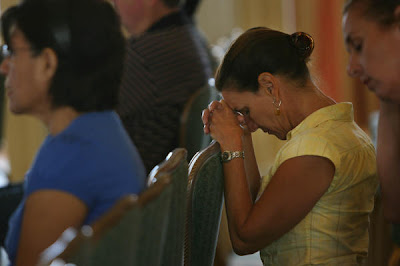Photo by Mayra Beltran, Houston Chronicle.
Galveston was hit hard by Hurricane Ike, and some of the most severely damaged public places were houses of worship.
But it takes more than wind and water to dampen people’s faith, as this report from the Houston Chronicle reminds us:
The churches remain standing.
The steeples still beckon in the Galveston skyline.
But open the doors, and there are no people.
“Right now, all we have is each other,” the Rev. Ron Pogue of Trinity Episcopal Church said from Austin, where he landed after leaving Galveston ahead of Hurricane Ike. “There is nothing we can do about the building.”
When Galveston formally reopens to residents Wednesday, many will return to homes devastated by a storm that trampled the island and left behind a pervasive film of sea, sewage and debris.
But they will also return to houses of worship, many of which stand on wobbly legs.
Though the churches and synagogues hold an important place in the lives of their members, those such as Trinity Episcopal also hold a spot in Texas and local history.
“Galveston has an extraordinary wealth of religious architecture from the 19th century,” said Stephen Fox, co-author of Galveston: Architecture Guidebook (Rice University Press, $17.95). “In addition, there is a very architecturally significant array of more modest church buildings, especially those associated with African-American congregations.”
Last week, most churches remained closed on near-empty streets with tree limbs, dried-up driftwood, waterlogged furniture and caked mud that cracked underfoot like ancient eggshells. Members of some churches and synagogues gathered in hotels, basketball courts and sanctuaries without power for weekend services.
Others such as First Baptist Church and Trinity Episcopal started the work of cleaning up, flinging doors open to exchange heavy, moist air with breezes and dehumidifying machines that buzz overtime to save any interior woodwork that withstood the initial trauma.
St. Mary Cathedral Basilica, Texas’ first Catholic cathedral, was most hard hit of the island’s Catholic churches, said Cardinal Daniel N. DiNardo of the Archdiocese of Galveston-Houston, who ventured Thursday to Galveston.
“There it is, standing,” DiNardo said. “So that is good. But there really is a lot of water damage and mud. It is just heartbreaking.”
The cathedral basilica, which shares duties as the home pulpit for the cardinal with the Co-Cathedral of the Sacred Heart in downtown Houston, is a significant historic building for Texas.
“It was the first monumental work of civil architecture built in Texas after the Spanish mission churches of the San Antonio River Valley,” said Fox, an adjunct lecturer at Rice University and the University of Houston.
The basilica, completed in 1848, was also the first substantial example of Gothic revival architecture built in Texas, he said.
In addition to the basilica, the Sacred Heart Catholic Church suffered water damage. But the gleaming white exterior — a religious fortress, rebuilt after being destroyed in the storm of 1900 — remained largely unharmed, DiNardo said.
Among the archdiocese’s oldest churches in Galveston, St. Patrick fared the best, he said.
Already crews have assessed the situation and expect to get to work soon, DiNardo said. The costs of cleanup and restoration were not yet calculated, he said.
Repairing the basilica would be a priority, DiNardo said. But churches on the mainland also suffered damage. Helping those in need after the storm and restoring parish life would also require immediate attention.
“The people … are the priority,” DiNardo said.
Check the link for more. And let’s remember these folks in our prayers.


